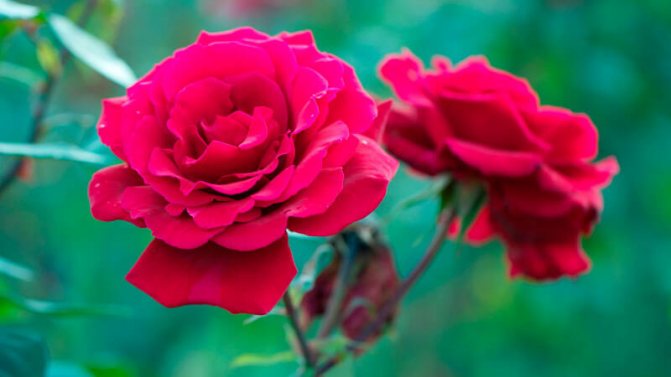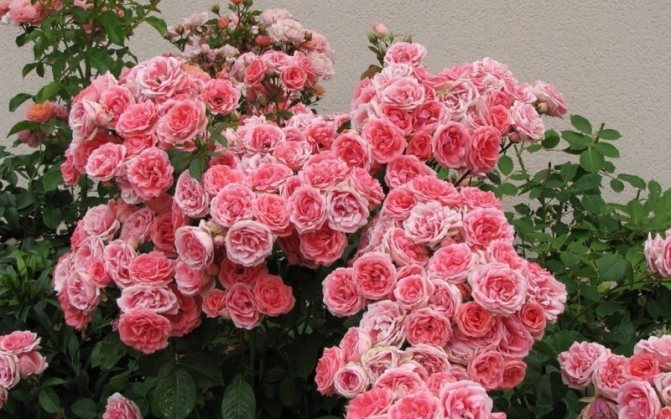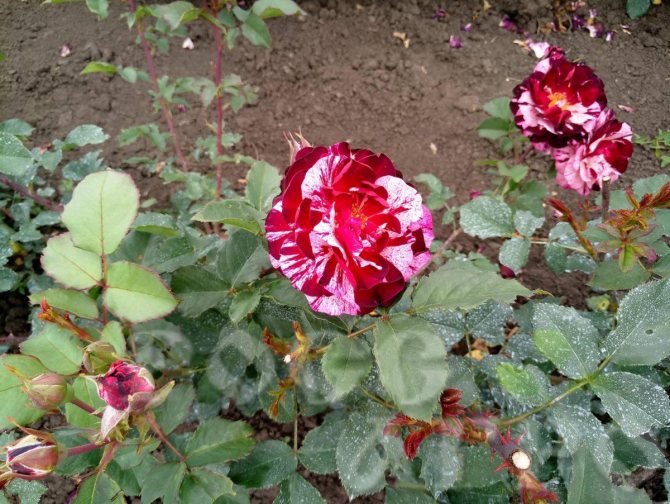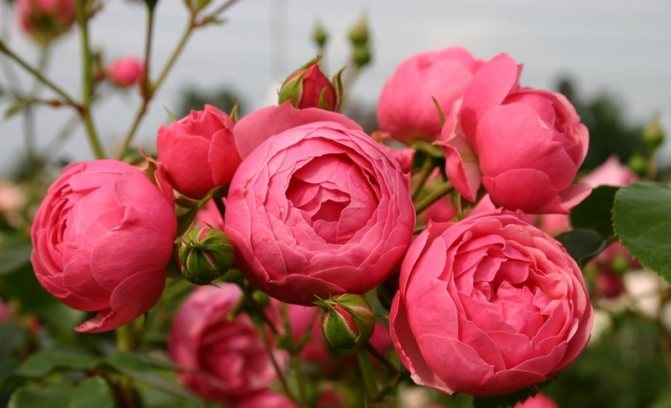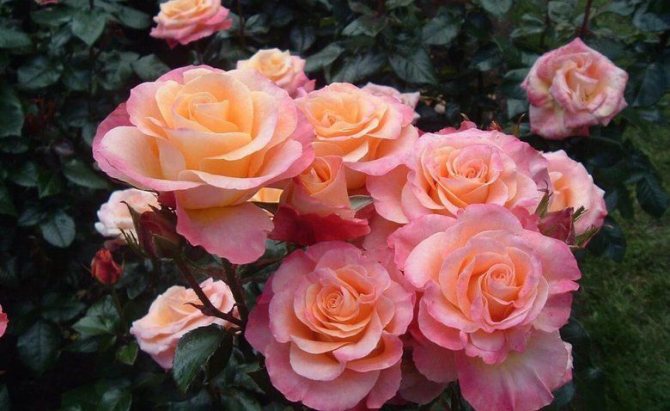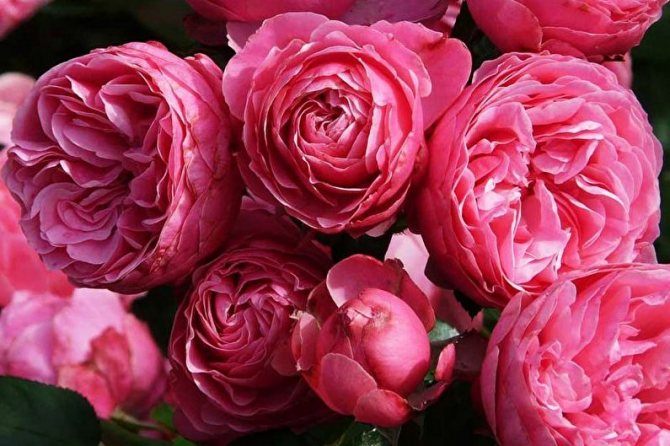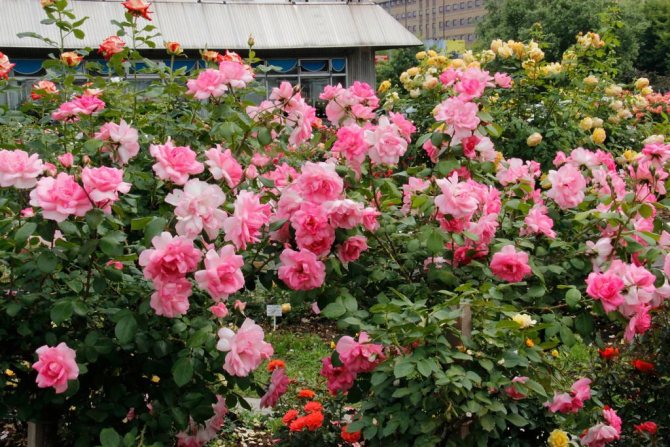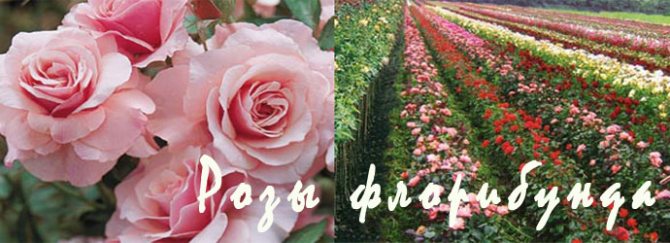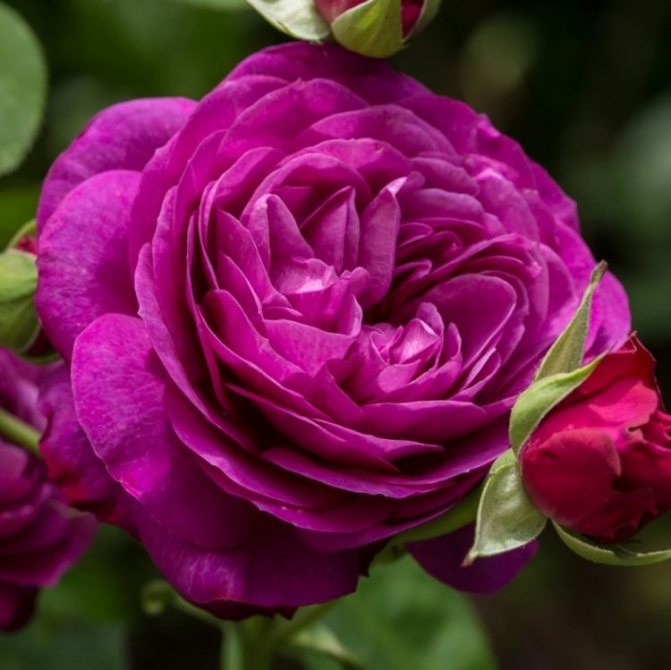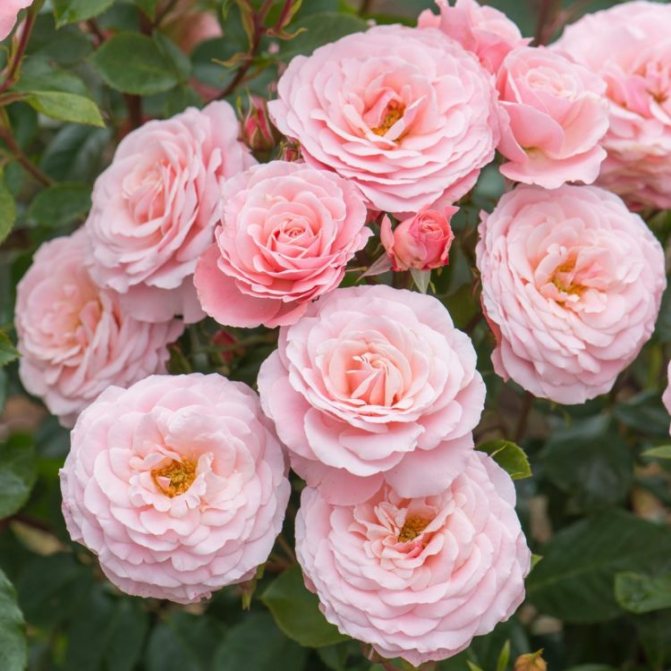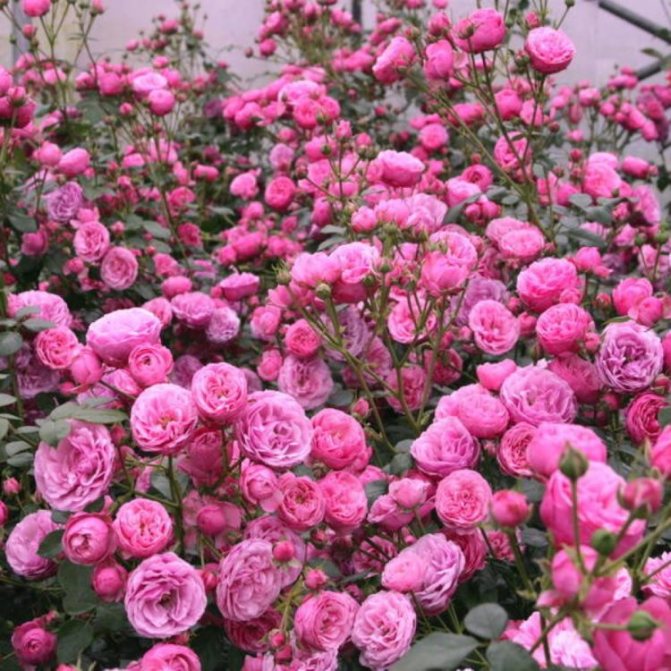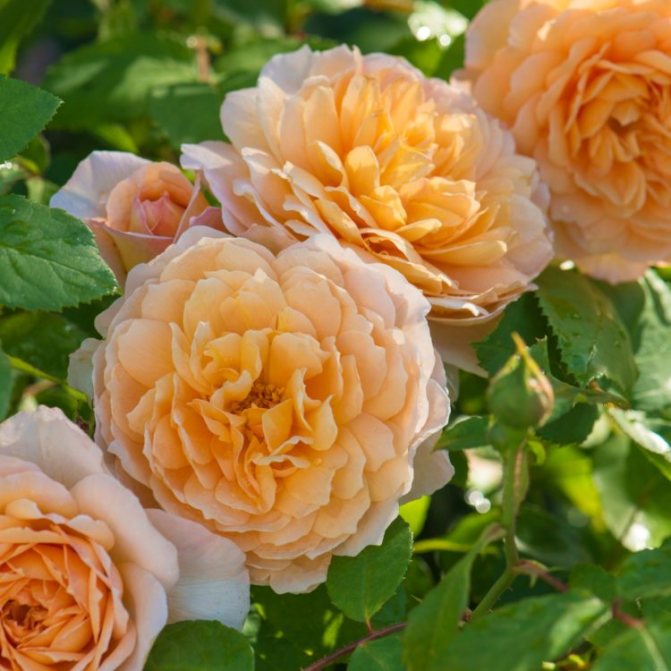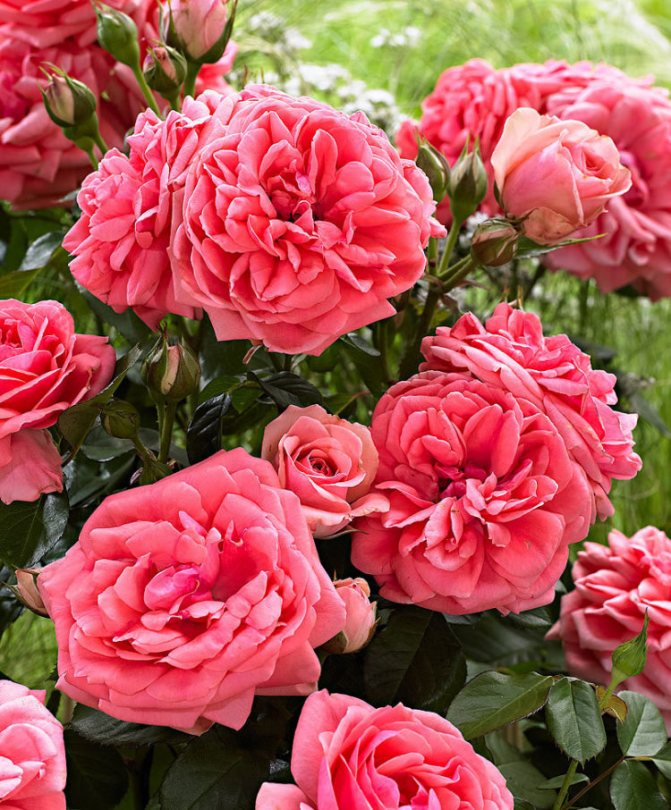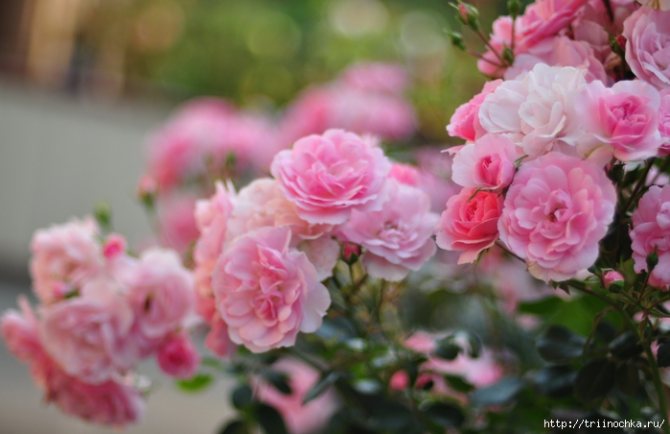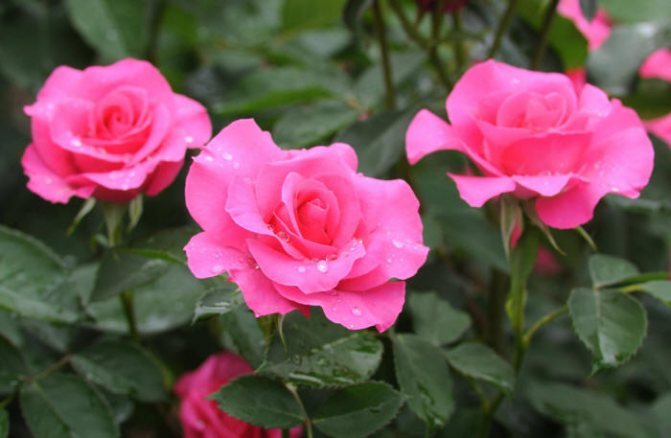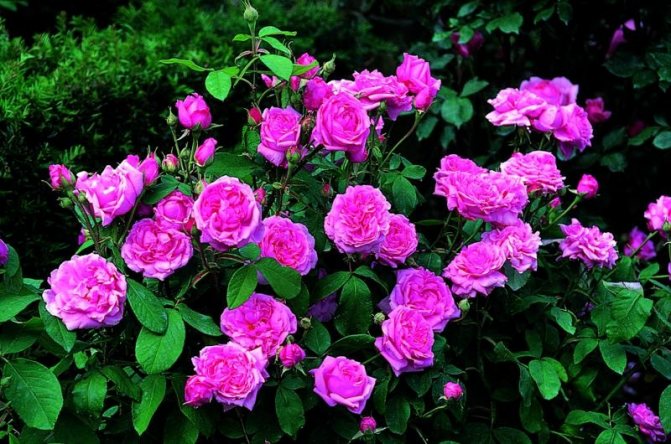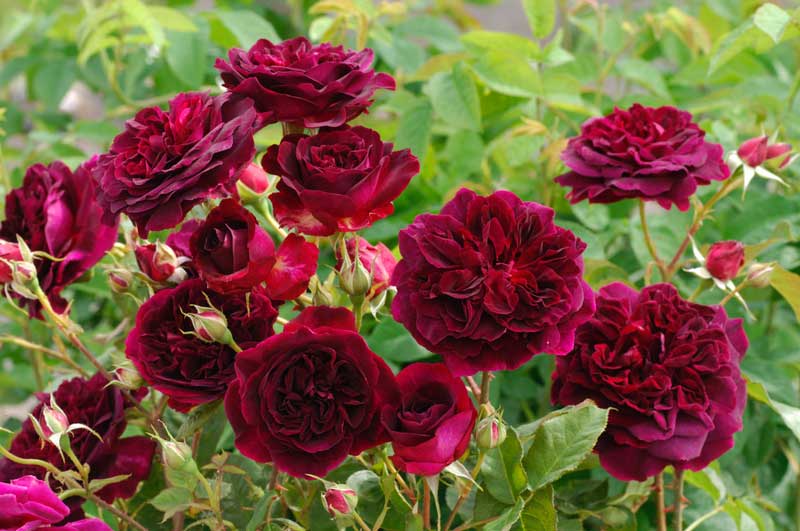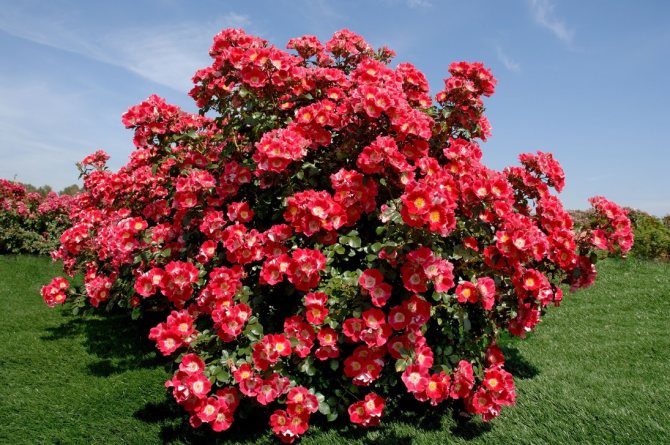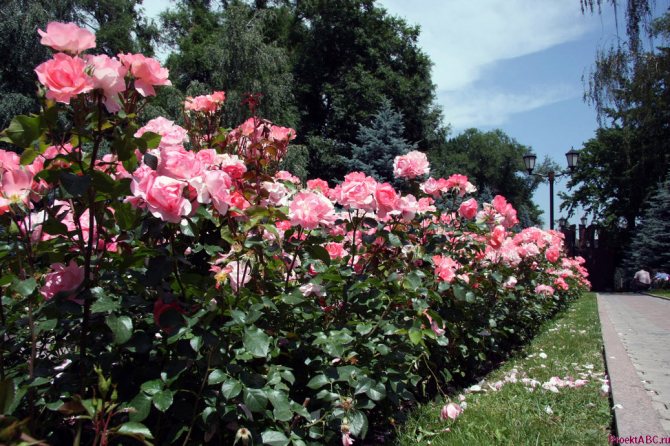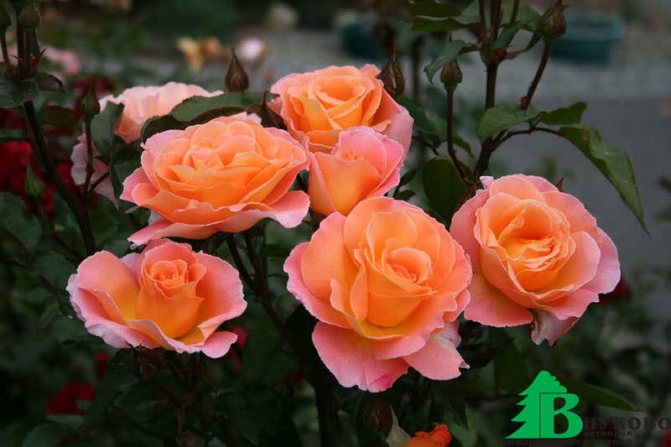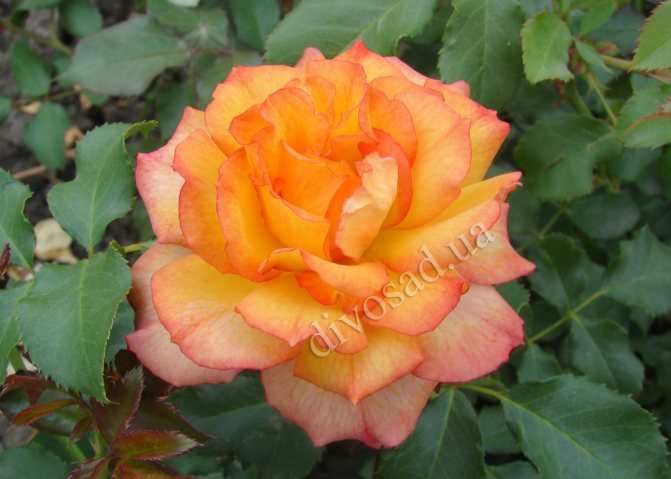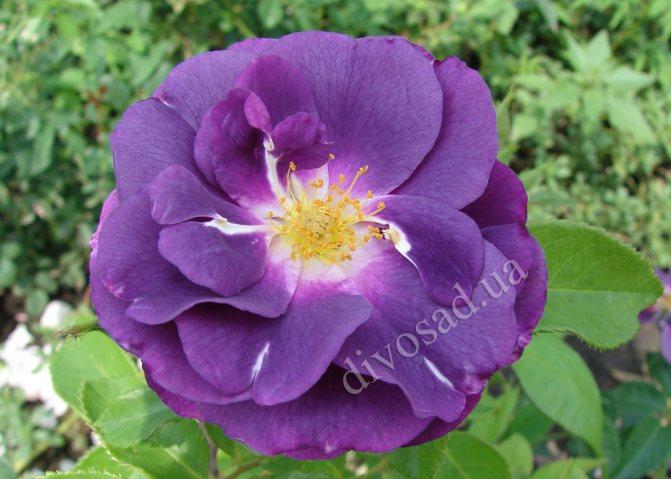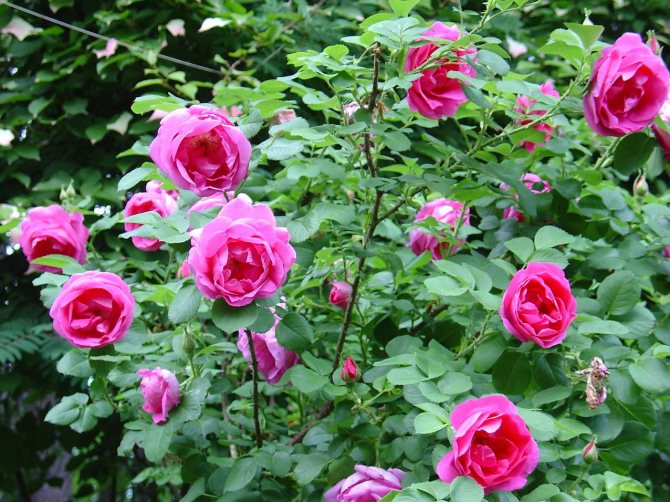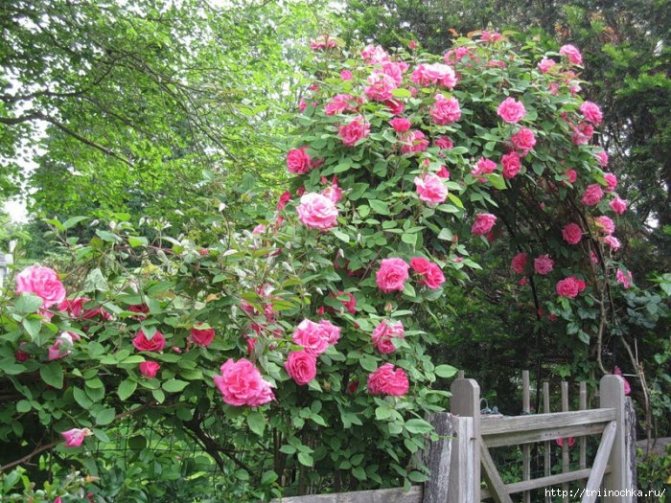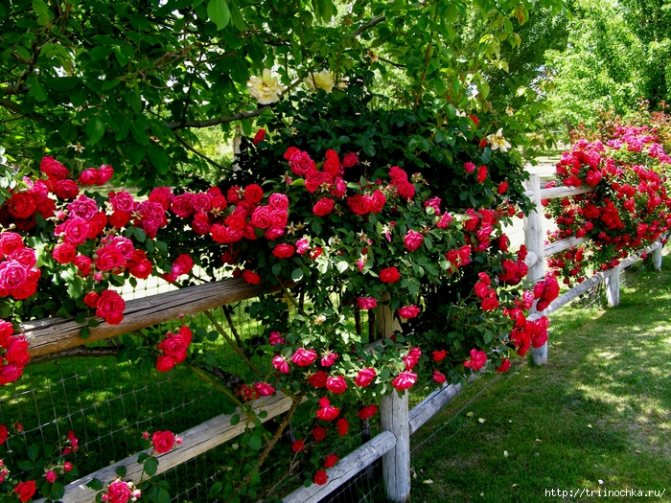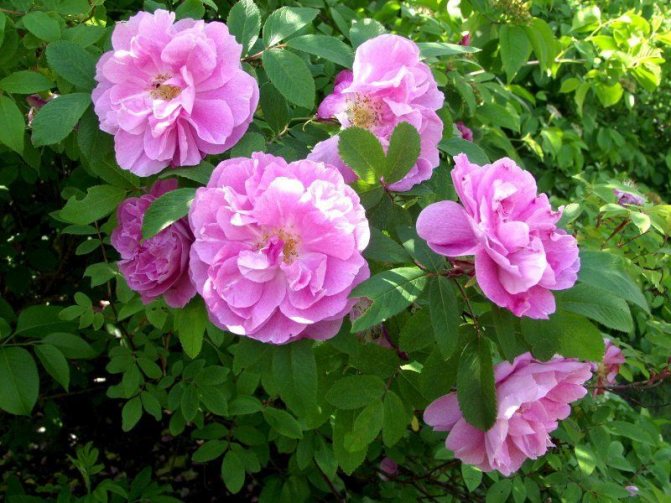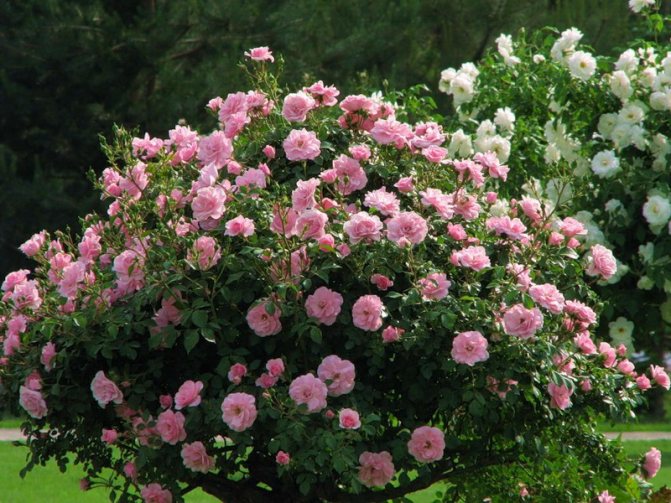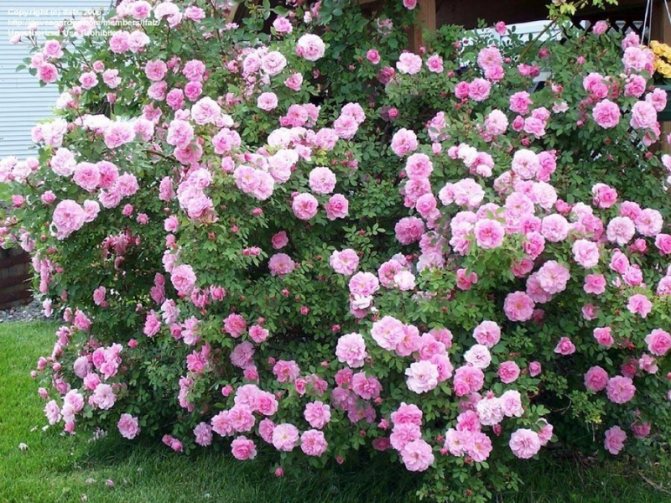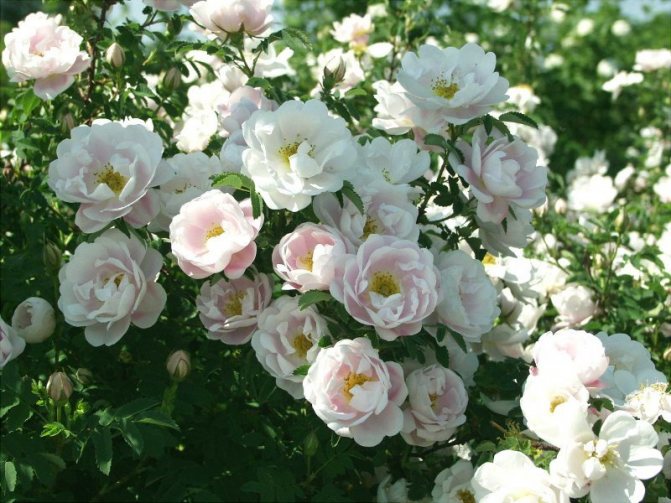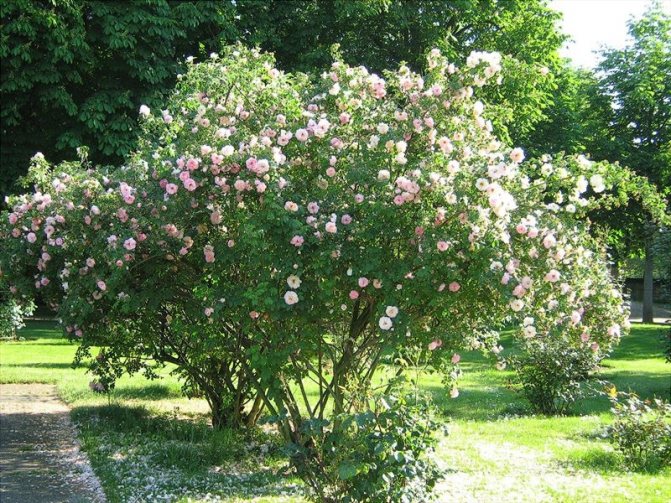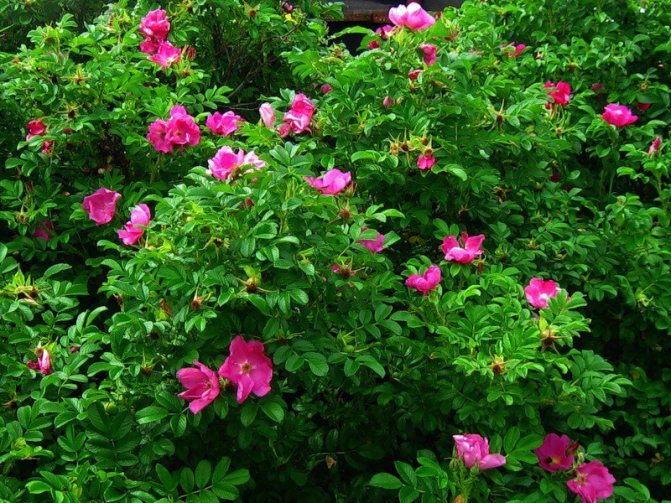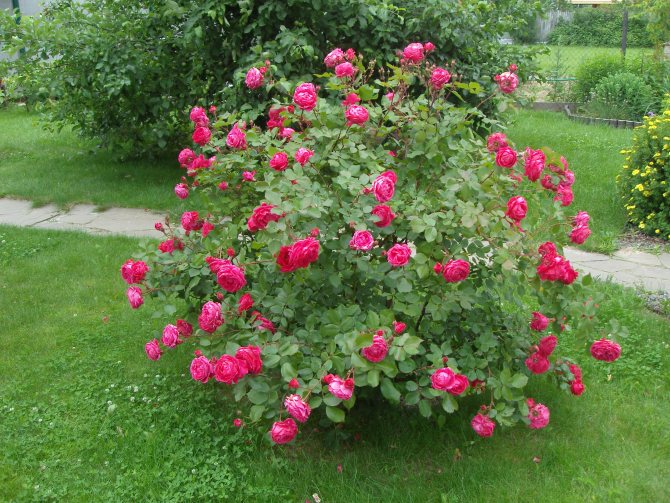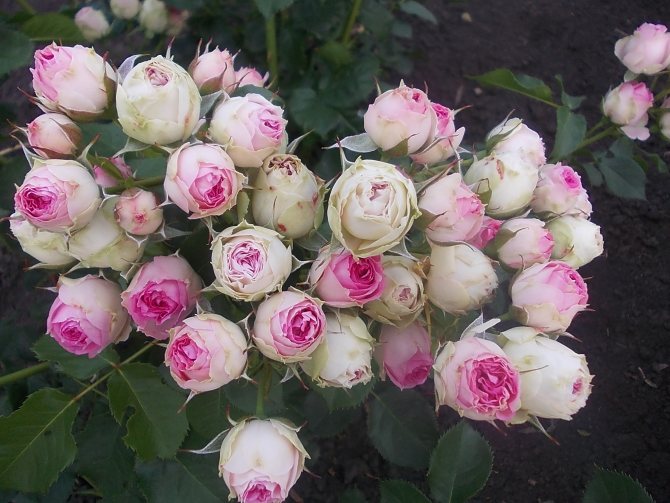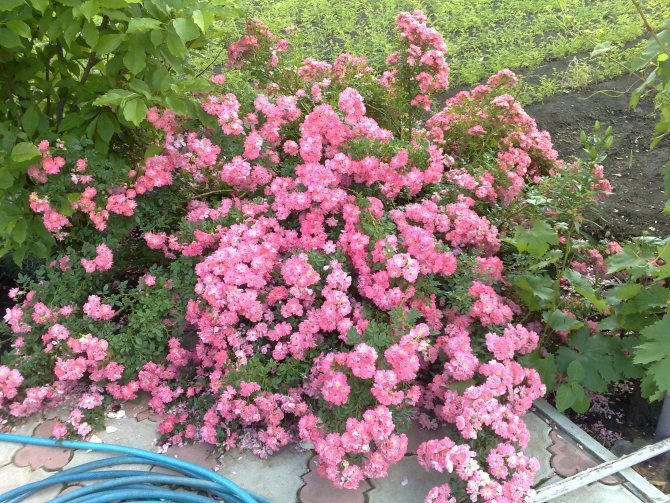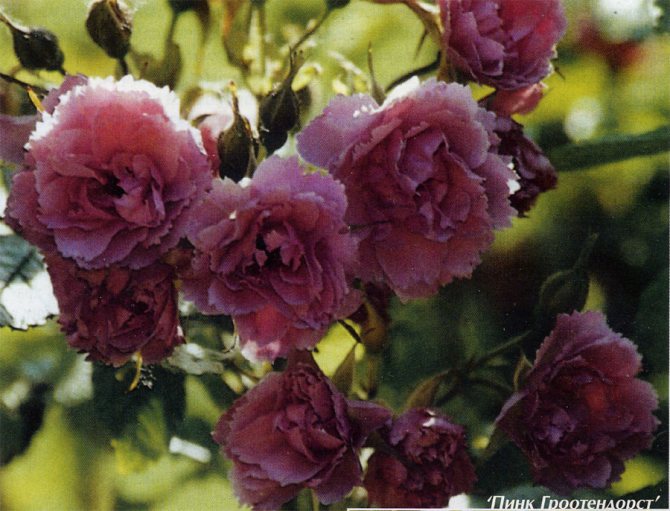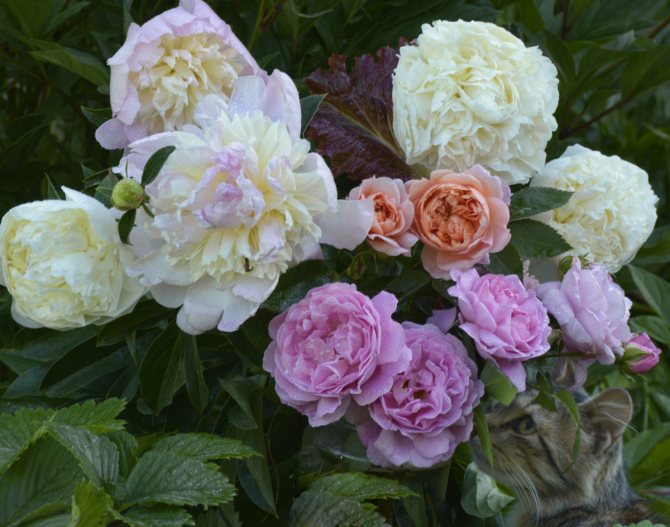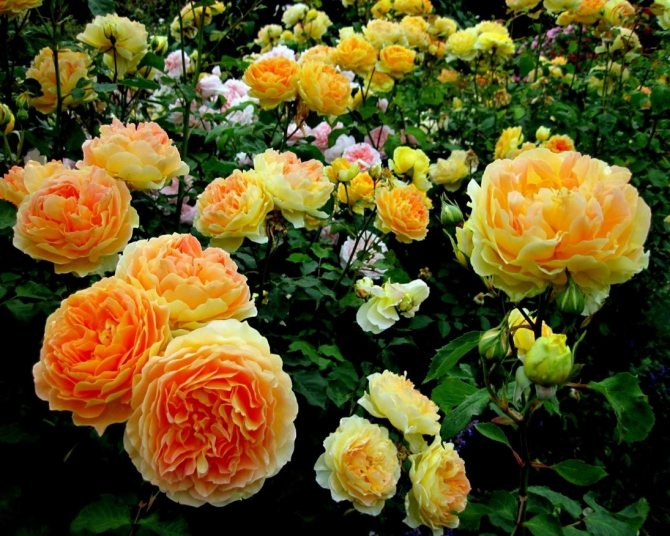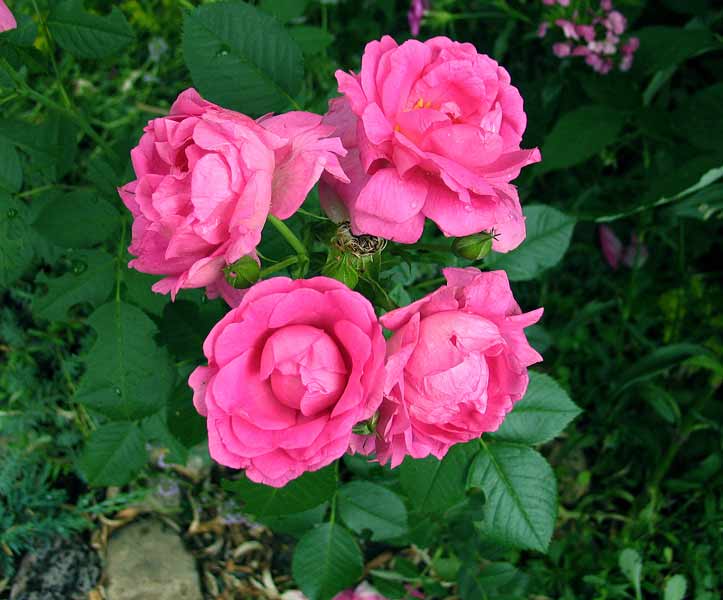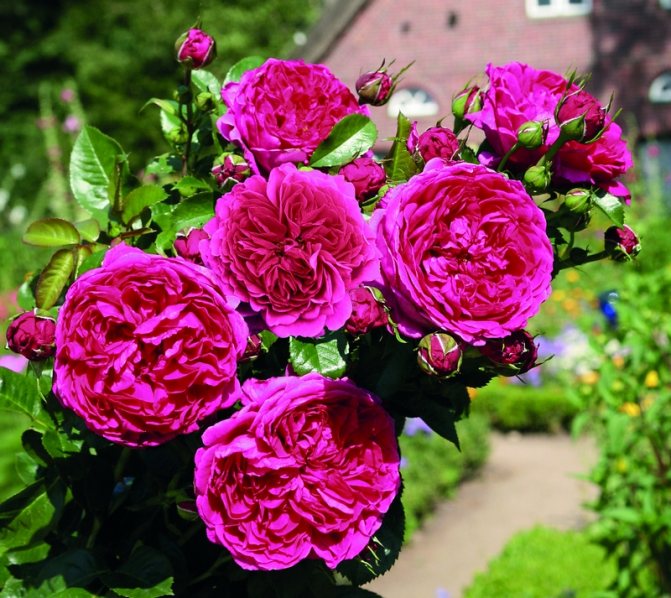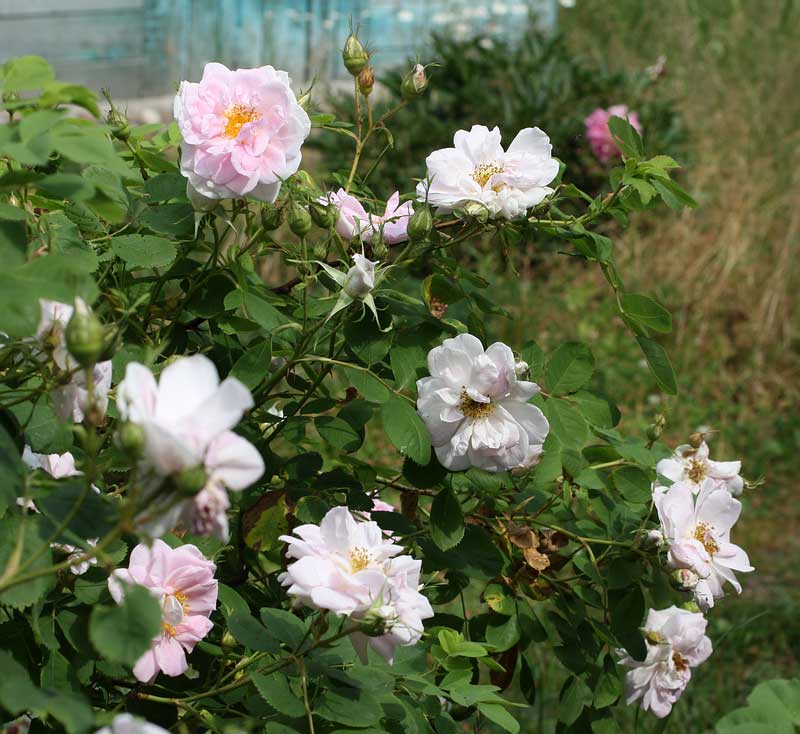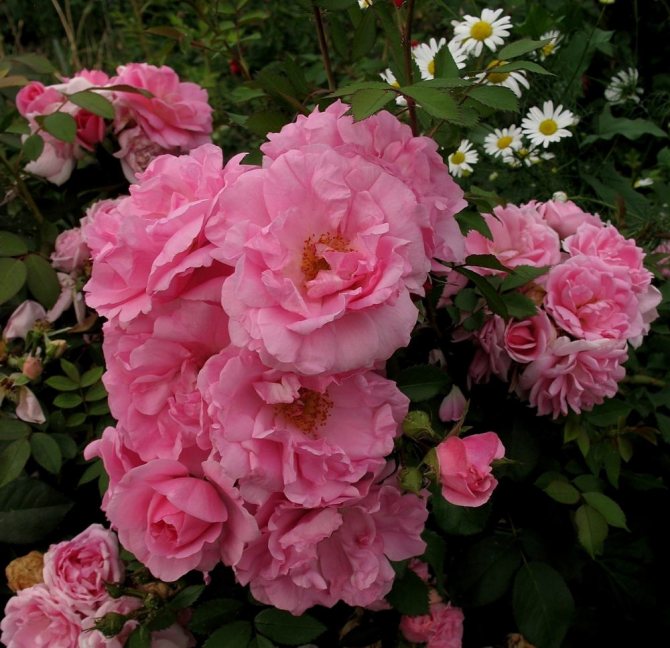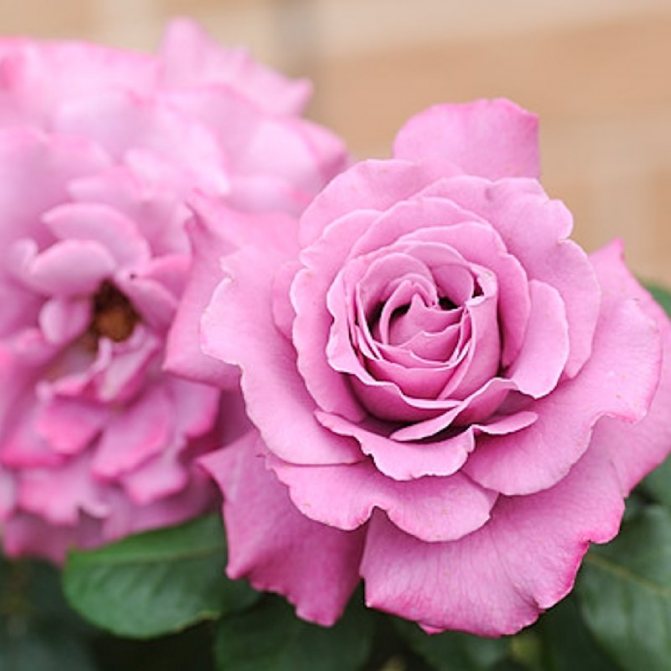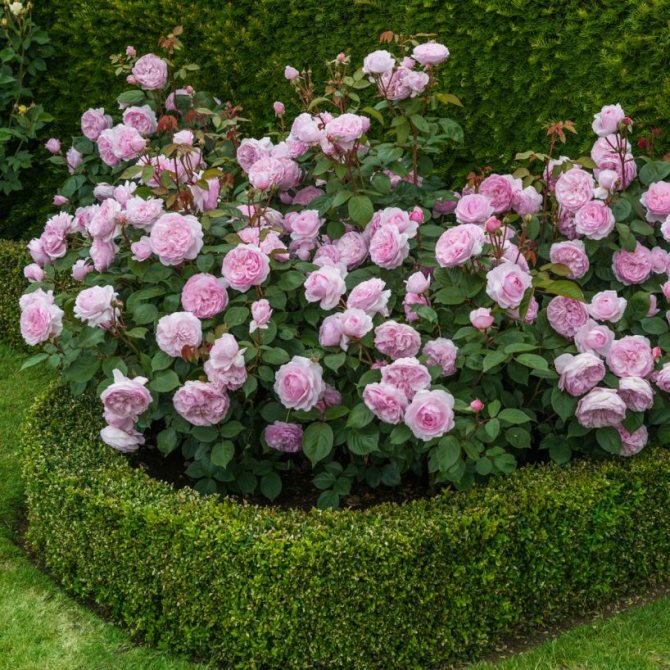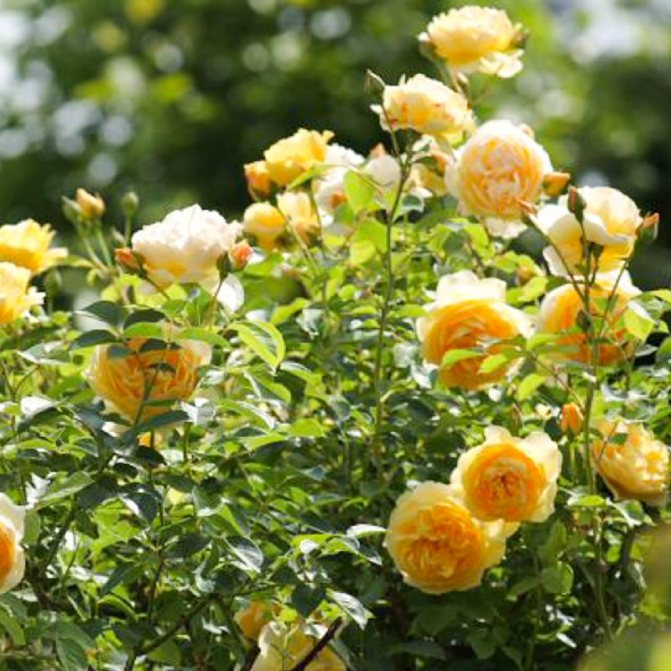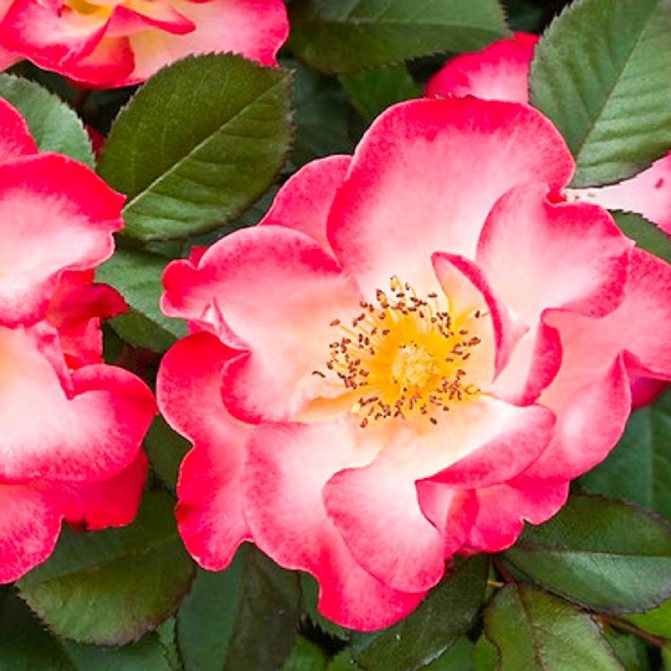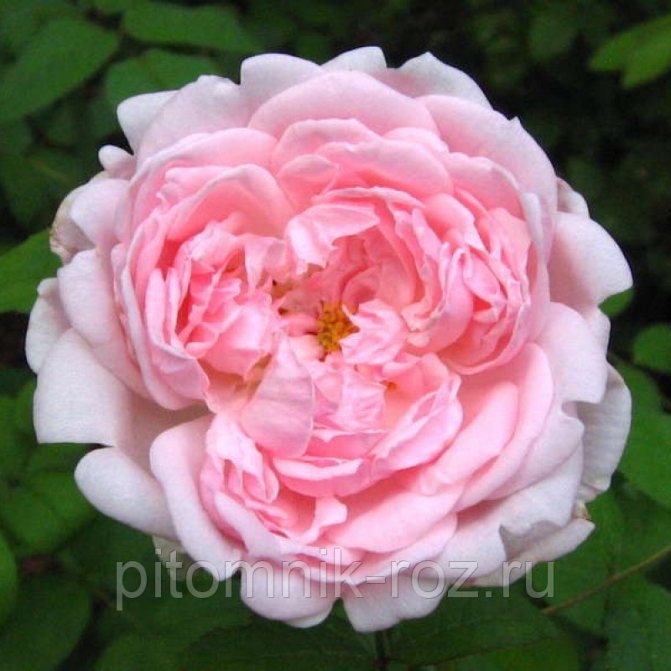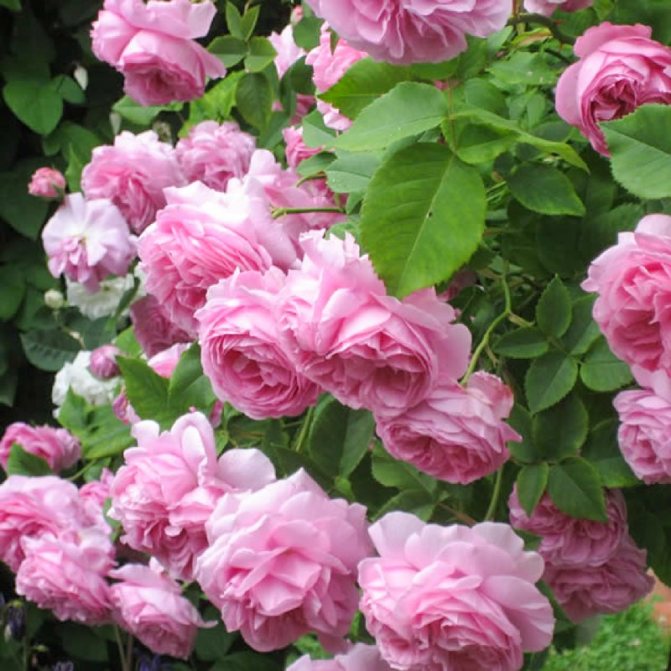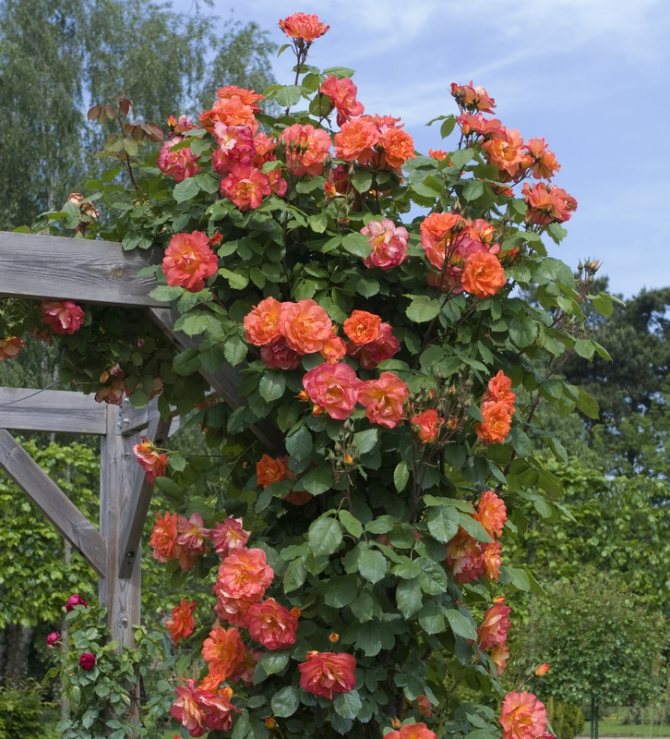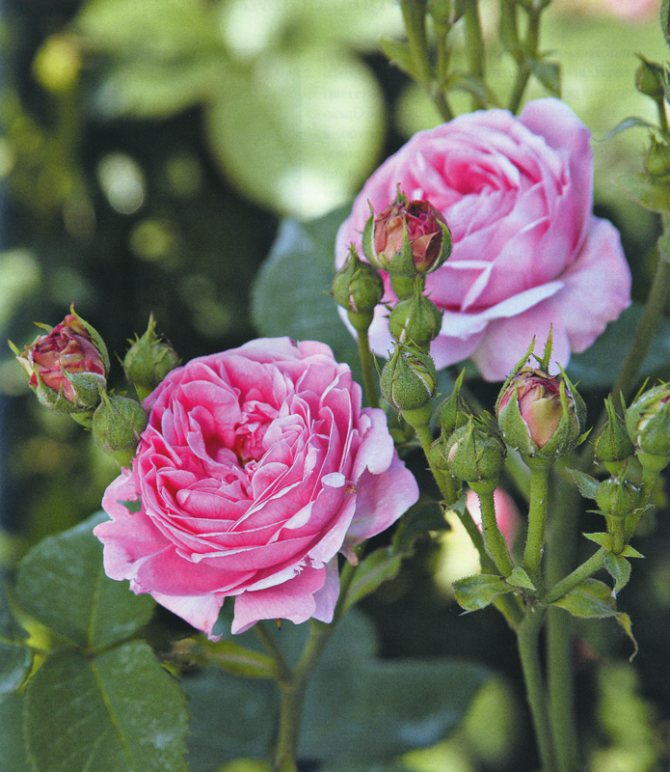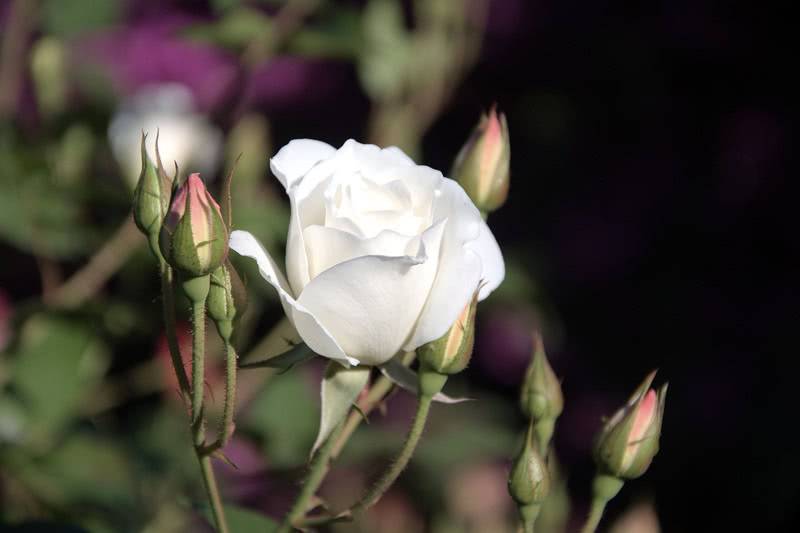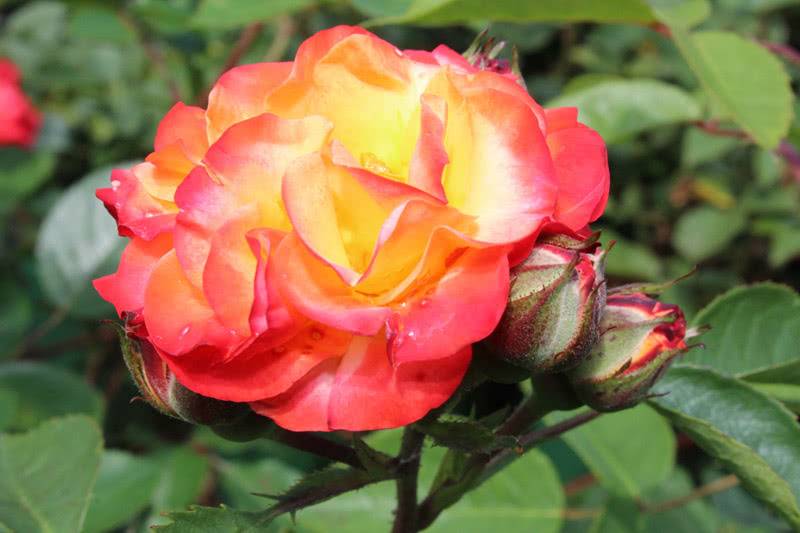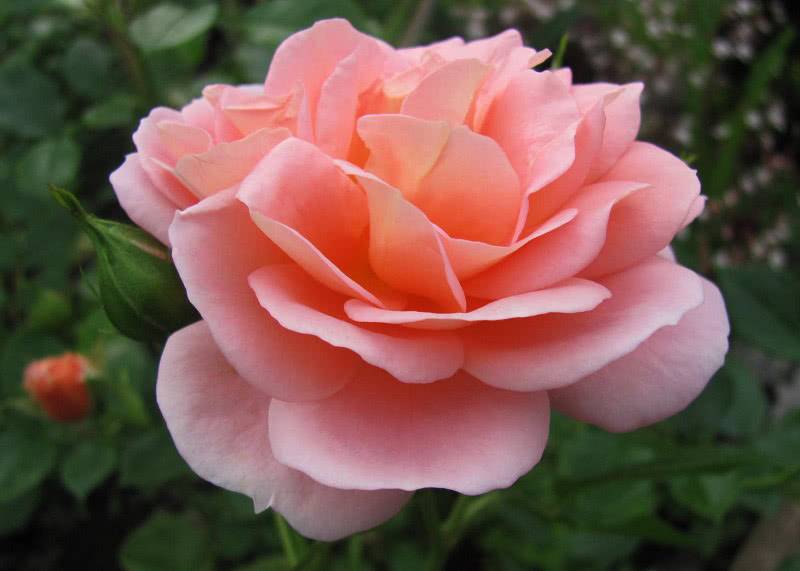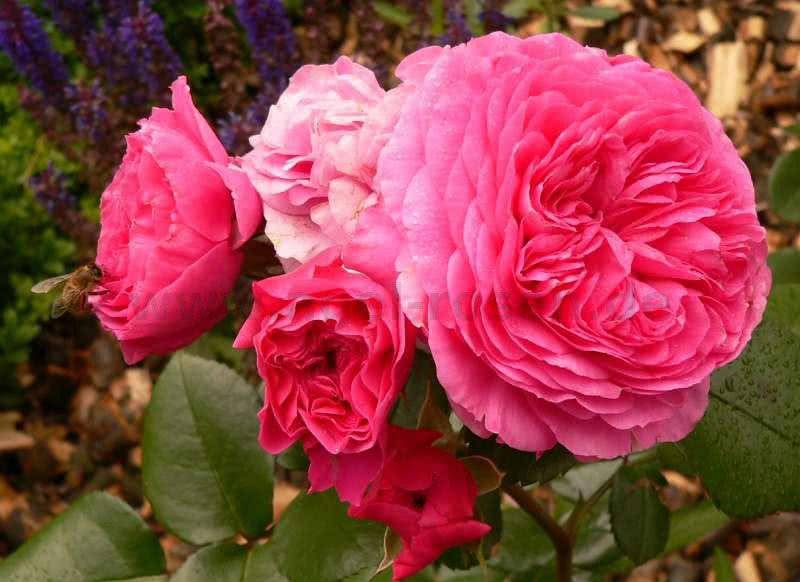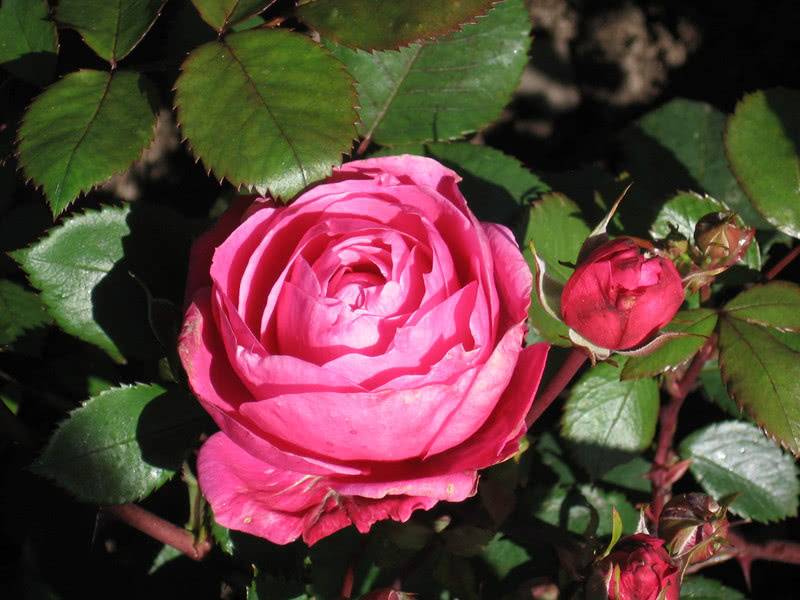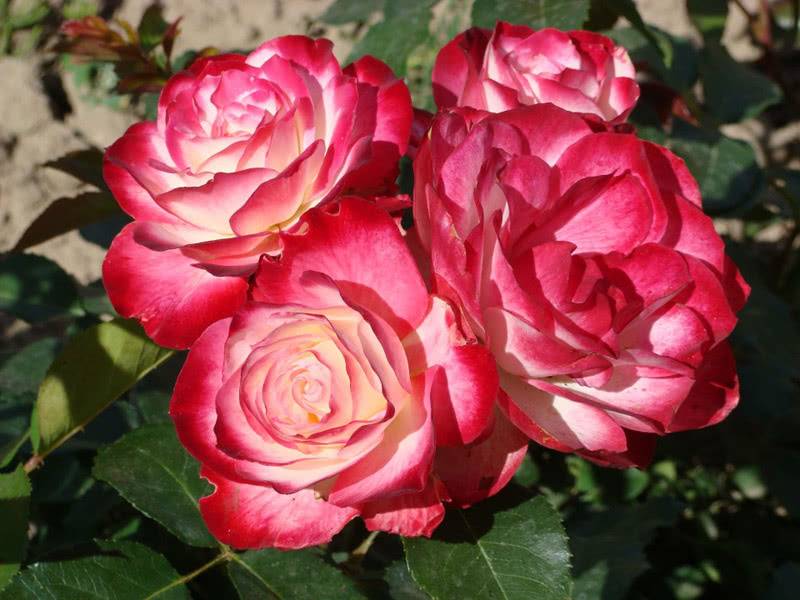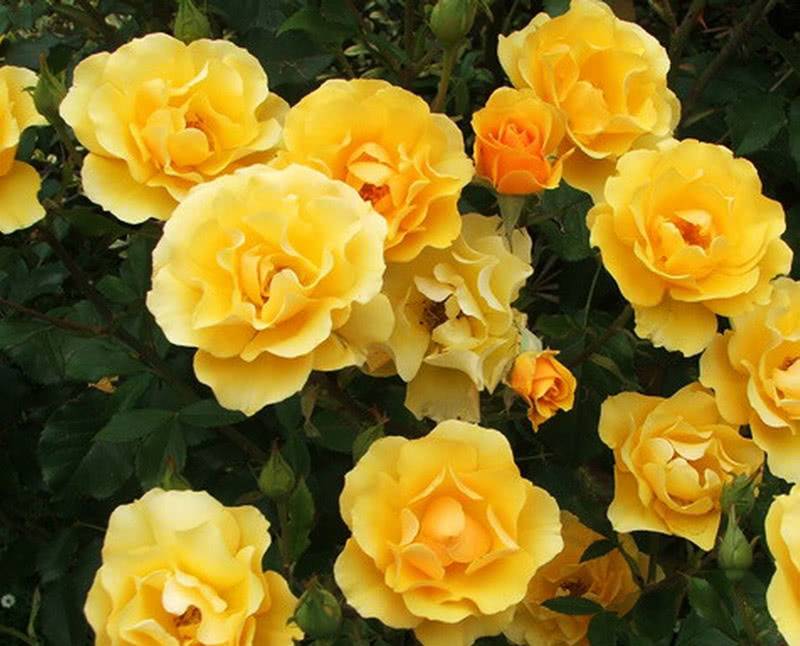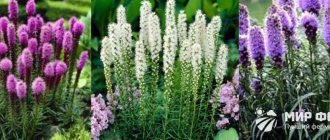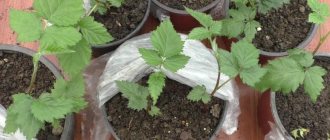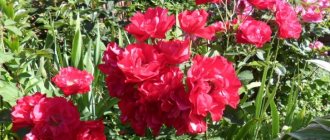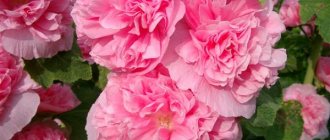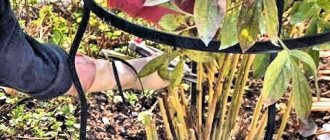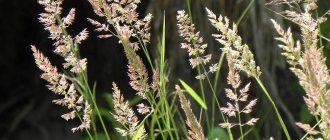A rose is a wonderful flower that will decorate any flower bed. Today there are a huge number of species of this plant, and the Floribunda variety is one of the most common. This is not surprising, because it has decent external qualities and has increased resistance to external factors.
The very name "Floribunda" is translated as "profusely flowering". The variety was developed through the long efforts of breeders. The work was started back in the 20s of the last century. Floribunda was officially registered in 1952. Breeding work continues to this day, now a large number of roses are known, which differ in the height of the bush, the number of buds, and their shade.
Floribunda rose variety
Dates of planting in open ground
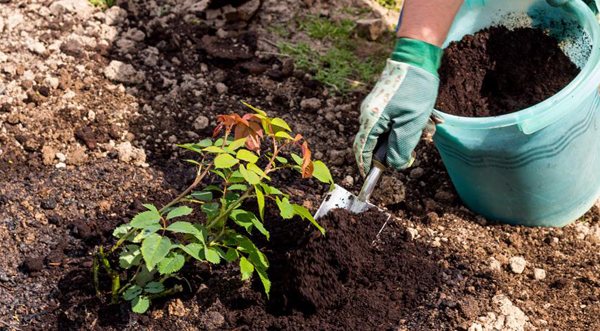
Rose seedlings are planted in the ground in spring or autumn, more precise dates depend on the climate in the region.
For the Moscow region and the Central strip, the approximate dates for planting roses: April 20 - May 30.
In autumn, planting is carried out from September 10 to October 20.
In the Urals and Siberia, the planting dates for the bushes are shifted by 2-3 weeks in advance.
Photo
Below you will see a photo of the flower:
How to choose the right seedlings
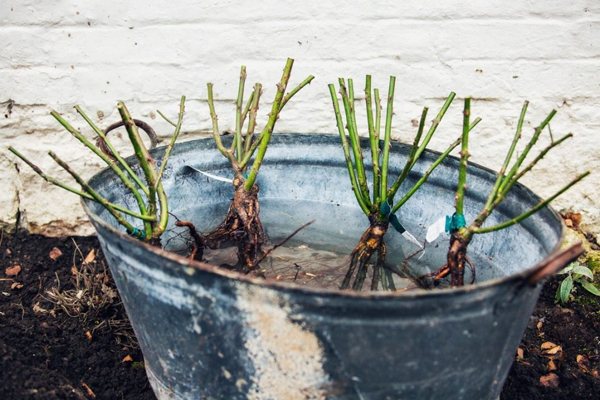

When choosing seedlings, the strongest are taken, with a green, whole bark and a strong root system of the plant. A healthy bush should have 2-3 strong shoots. The root collar above and below the inoculation should be of the same thickness and 5-8 millimeters in diameter. The roots should have many thin roots. The roots of dried seedlings are immersed in cold water for a day before planting.
Gallery: park roses (46 photos)
Features of growing floribunda roses
A characteristic feature of floribunda roses is the formation of many buds on the bush, collected in inflorescences. Plants at any age require a lot of nutrients and strength, so the main task of the grower when growing roses of this group is to provide them with comfortable conditions.
Site selection
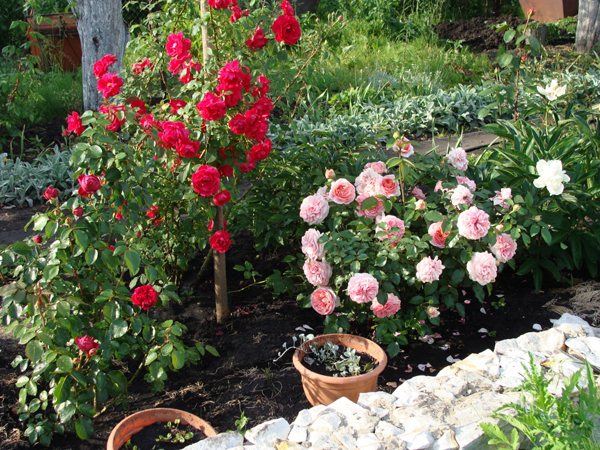

In order for floribunda roses to grow and delight with their flowering, you first need to properly prepare the planting site.
The site must be well lit, protected from drafts and low (less than 1 meter) groundwater. The most suitable place for rose bushes would be the south side on an elevation or slope. In the afternoon, the planted bushes should be slightly shaded. This prolongs flowering, protects against sunburn, color burnout and premature drying of the shoots.
Suitable soil


Floribunda roses grow best in sandy-clay or sandy loam soil. In this case, the soil should be loose and breathable. You can make the soil looser by introducing a small amount of humus into it.
Before planting, the place where the seedlings will be planted is dug to the depth of the shovel. When digging, rotted compost (manure) and phosphorus fertilizers are introduced. Fresh manure is introduced in advance, it must have time to burn out in the soil, since when planting it can harm the plants.
How to plant
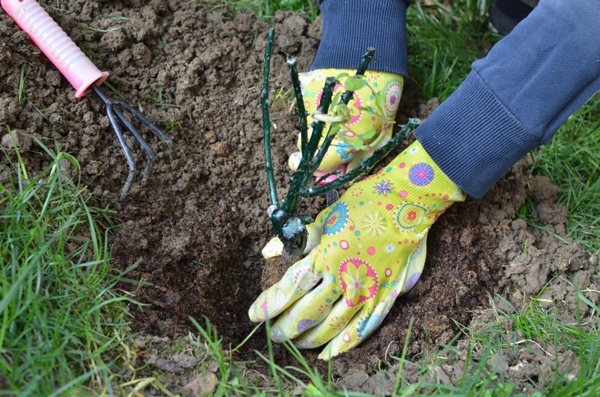

A hole for a seedling is dug in advance, while the top fertile layer of earth is removed and deposited. The depth of the hole is determined by the grafting site, which after planting should be 3-8 centimeters in the soil.The width of the fossa is 60 centimeters.
At the bottom of the pit, a drainage layer of small pebbles, vermiculite, expanded clay is poured, which will ensure the outflow of excess moisture.
The cut off top of the soil is mixed with rotted compost, rotted manure and phosphate fertilizers.
On the roots of the seedling, dry, damaged processes are removed with a sharp and disinfected pruner. The main roots of the rose are shortened to 20-25 centimeters.
The seedling is installed vertically, the roots are gently straightened. The soil is poured into the hole in portions and slightly compacted by hand. There should be no voids near the roots after filling the fossa.
The root collar after filling the fossa should be deepened by 5-8 centimeters.
After planting the plant, the ground is watered, and the root area is mulched with fine straw, rotted humus, sawdust of coniferous trees or peat.
The aboveground part of the seedling, after planting, is shortened to 30-35 centimeters from ground level.
There is another method of planting floribunda roses, which reduces the possibility of air voids in the roots of the seedling.
To plant a plant, a hole is dug 30 centimeters deep and 60 centimeters wide.
A bucket of an aqueous solution with sodium humate in the consistency of weakly brewed tea and a Heteroauxin tablet is poured into the prepared hole with drainage.
A seedling is placed in a hole with water. The plant must be placed in water up to the grafting level. The earth is poured and slightly compacted.
After such a planting, watering is not carried out. The area around the seedling is covered with mulch.
In the first 1.5 weeks of growth after planting, the rose seedling must be shaded with spunbond, lutrasil, so that direct sunlight does not fall on it. Then the protective material is removed.
Features of planting floribunda roses in the ground in spring: video
The consequences of improper cultivation
If you take care of the plant incorrectly, it can be susceptible to diseases and pests:
- rust;
- powdery mildew;
- black spot;
- aphids.
When the first symptoms occur, it is necessary to remove diseased or affected shoots and spray all available bushes with chemicals.
Due to the duration of flowering, frost and disease resistance and lush flowering, floribunda is currently in great demand in garden and landscape design. Its beautiful flowers, distinguished by a variety of colors and graceful simplicity of shape, captivate both beginners and experienced gardeners and collectors.
If you decide to start breeding and growing Floribunda, then you need to know that there are a lot of varieties of this flower and each has its own distinctive features. Read about varieties such as Jubilee of the Prince of Monaco, Aspirin, Pink, Nina Weibul, Midsummer, Leonardo da Vinci, Coco Loco, Mona Lisa and Novalis.
Outdoor rose care
After planting rose seedlings in a permanent place of growth, they are provided with proper care, since the abundance of flowers, the health and appearance of the bush depend on it.
Watering
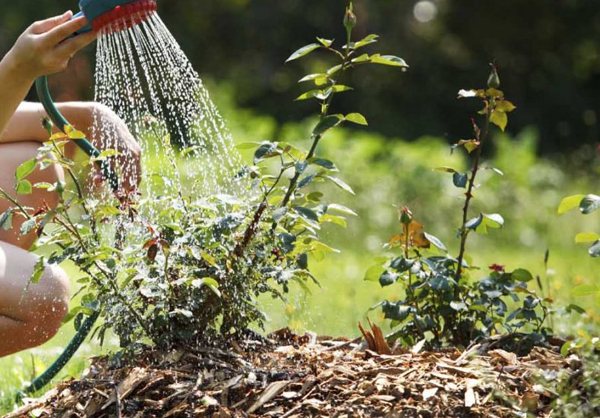

For roses, abundant and timely watering is important. The ground under the bushes should always be slightly damp. Watering is carried out in the evening or early morning.
When watering in the evening, the settled water from the watering can without a sprinkler is poured in a trickle to the base of the bush, into a small hole made around the plant. In this case, water should not fall on the leaves.
Sprinkling roses are watered only in the morning so that the moisture on the leaves has time to dry out by evening.
In summer, the number of waterings gradually decreases, and in September they stop. This is necessary so that new shoots do not appear on the plant, which will weaken it during wintering.
If in the fall, a few weeks before the shelter, there is no rain, you need to water the bushes 1-2 times a week, because you cannot leave roses for the winter without moisture in the roots, this will weaken them.
Top dressing
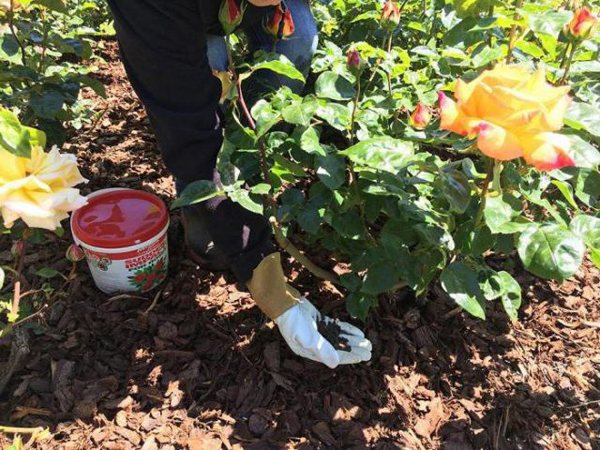

Roses require regular feeding for full growth and budding of the bush.
In heavy soil, it is undesirable to fully fertilize roses.
Rose bushes are sensitive to salts in the soil. In heavy soil, they are washed out with difficulty, therefore, combined fertilizing is used in a minimum amount.
The bush is fertilized in the second year of growth. Top dressing is carried out annually: in spring, summer and autumn.
In the spring, after the roses are opened, 60-80 grams of complex fertilizers are applied per 1 square of the area. Fertilizers are evenly spread over the surface and embedded in the soil with a rake.
In mid-May, when buds appear on the rose bushes, after watering or rain, the plants are fertilized with a solution of fast-acting mineral fertilizers (30 grams of top dressing per bucket of water). 3 liters of solution is poured under one plant. At the end of June, nutrient watering is repeated.
In late October - early November, potash and phosphate fertilizers (which do not contain chlorine) are scattered over the surface of the earth, 30 grams of each top dressing per 1 square of area. If the rose bushes take cover for the winter, raking the soil on them, additional fertilizers are applied after the bushes are covered.
Mulching
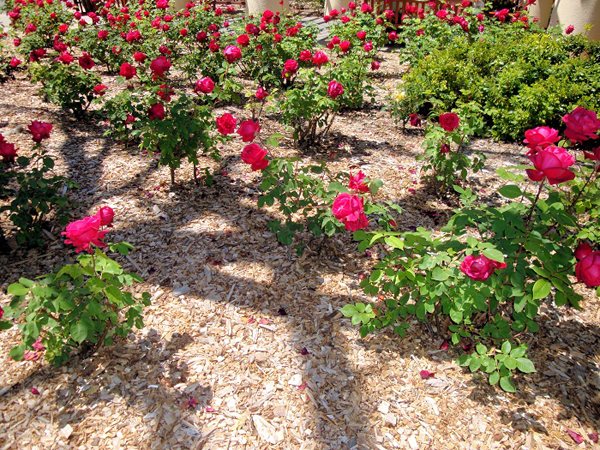

Roses need loose soil, where heat, moisture, air can easily penetrate. Regular loosening of the soil saves water for irrigation and fertilizing. When loosening deeply, there is a possibility of root damage. In order to prevent the soil from compaction, it must be loosened to a depth of no more than 10 centimeters or covered with mulch, which will retain moisture in the soil.
Mulching is carried out after watering and feeding the bush. For mulch, needles, last year's sawdust of coniferous species, chopped straw, peat, rotted humus are taken. The mulch is scattered in an 8-10 cm layer around the bush.
Pruning


Pruning roses is a must for full growth and flowering of bushes. It is held in spring and autumn, in front of the plant shelter. This removes dry, frozen, thin stems. The strongest shoots remain.
During spring pruning, 3-5 stems should remain on the bush. The remaining branches are additionally pruned to a height of 4-5 buds (stems should remain from the ground, about 10 centimeters long). If there are shoots on the sides, they are also trimmed.
Floribunda rose - pruning, cultivation features: video
Description of the variety
Floribunda means that the bushes have a lush and abundant flowering. There are a huge number of subtypes of varieties that differ in appearance. No other group has so many varieties. Flowers can be simple, and semi-double, and double, can have a goblet or flat calyx, can be collected in small or large inflorescences. The flower size is usually 4 to 9 cm.
Most Floribunda roses bloom in three approaches. Flowers gradually open in several pieces. There are also varieties that bloom continuously.
There are several advantages that make Floribunda roses stand out from the rest. This should include:
- resistance to low temperatures;
- resistance to typical flower diseases;
- ease of care;
- the possibility of propagation by cuttings.
Floribunda roses are actively used for outdoor landscaping of the territory. They look great in parks or in flowerbeds near large visited buildings. Some varieties are used as cuttings.
How to propagate correctly
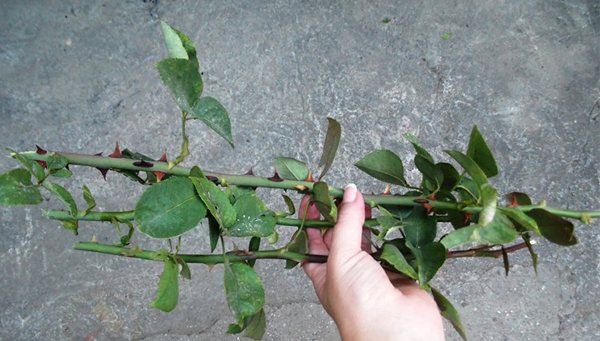

Roses reproduce well by cuttings. At the same time, lignified shoots are cut from the shrub. They take root in the fall or are stored until spring and planted later.
For planting, cuttings in the upper part are cut at a right angle, from the bottom at an angle of 45 degrees. The upper cut is processed with ash or crushed activated carbon, and the lower one - with Kornevin.
The cuttings are buried in the prepared soil and covered with a two-layer non-woven cloth or cut plastic bottles.
Cuttings grow in a planting place for 2 years, for 3 years grown bushes are planted in a permanent place.
Soil and planting site
We recommend reading our other articles
- Raspberry variety Caramel
- Drinking bowls for chickens
- Guinea fowl breeds
- Carrot variety Queen of autumn
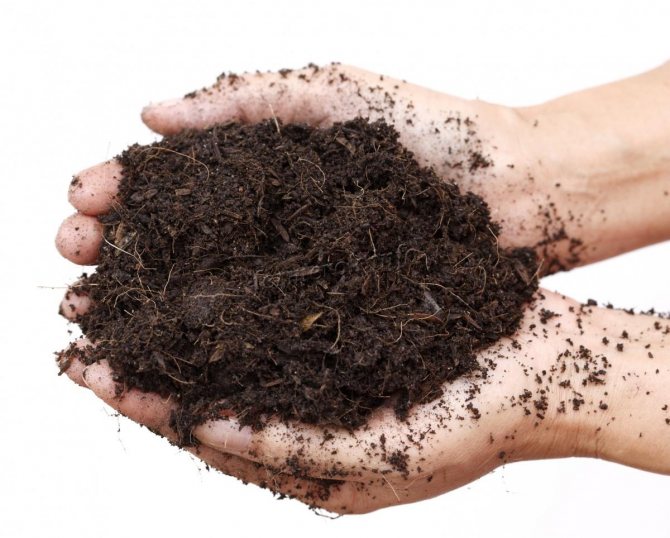

Soil for planting
The first thing you need to decide on before purchasing floribunda rose seedlings or digging out grown bushes obtained by cuttings is the place and soil for permanent planting.
- The site for planting should be in partial shade or in a sunny place where there is a thick shadow at noon, since the constant sun will simply burn the delicate leaves and petals of the buds. If the bushes are planted near the house, then it is better to choose the western wall or the eastern one, but certainly not the southern or northern.
- The best soil option is sandy-clayey. The ground should be loose for better breathability. If the roots lack air, the buds will not be bright. Heavy soil can be diluted with humus or sand.
Protection against diseases and pests
Floribunda roses, despite their high resistance to diseases and pests, with improper care of them, they, like other types of roses, albeit to a lesser extent, also begin to hurt or become covered with pests.
Diseases
Black spot
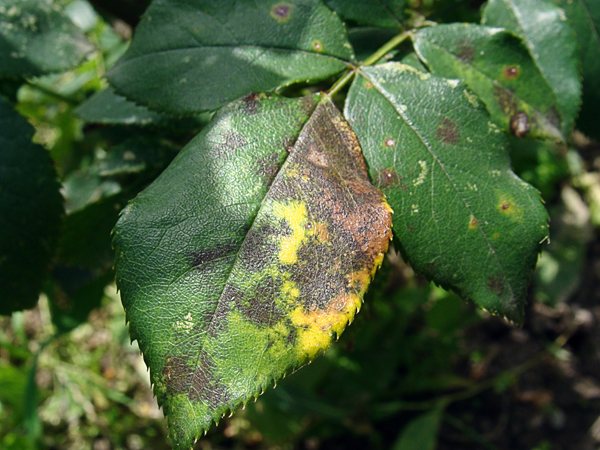

When the disease is affected, black spots form on the leaves, they turn yellow from below, dry out and crumble. Typically, mottling appears in mid-summer, with the disease peaking towards the end of summer.
The disease appears due to sudden changes in temperature and high humidity.
Regular spraying of the bushes with a decoction of horsetail or nettle infusion prevents the appearance of this disease.
When a disease is affected and for prevention, drugs are used: Profit, Ridomil Gold, Skor, Topaz, Fitosporin.
Diseased leaves on the bush are torn off and destroyed.
Rust
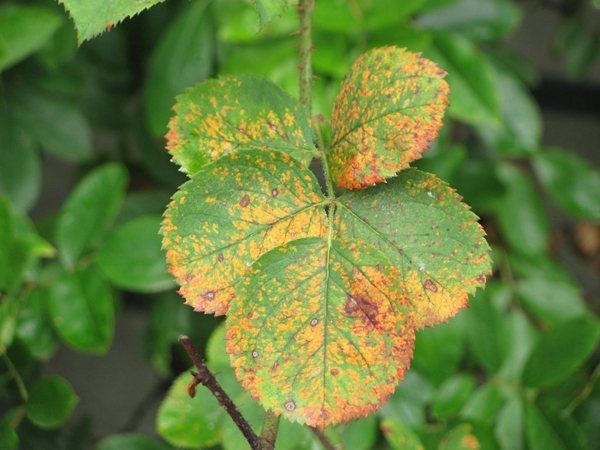

In spring, bright orange tubercles appear on young shoots and leaves with this disease. Over time, they darken and grow. The disease weakens the bush.
The spread of the disease occurs due to the high humidity of the air, and in hot, dry weather, the development of fungi is inhibited.
You can fight the disease with the same drugs that help with black spot.
Additionally, the affected bushes are heavily pruned in the spring, and the removed shoots are destroyed.
With a high degree of damage, the bushes are dug up and removed from the site.
Powdery mildew
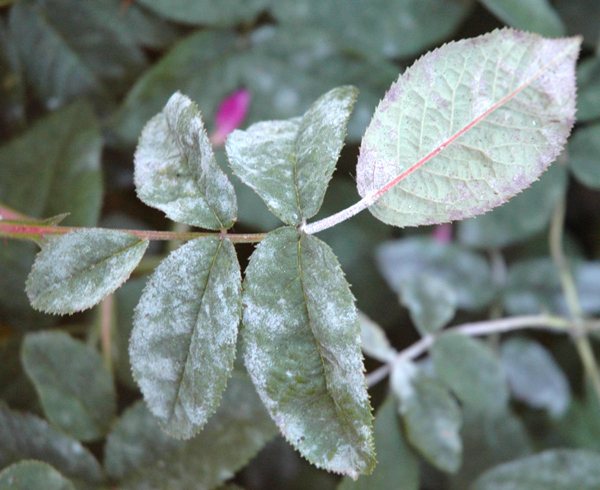

The disease appears in cool, humid weather. A whitish bloom appears on young shoots, leaves and buds.
The appearance of the disease is facilitated by a lack of light, an excess of nitrogen in the ground and thickened plantings.
At the onset of the disease, dusting with wood ash helps. The bush is sprayed with water and on top, sprinkled with ash, after 2 hours everything is washed off.
In case of severe infection, antifungal drugs are used. Previously, all diseased leaves are removed on the bush before processing.
Pests
Bronzovka
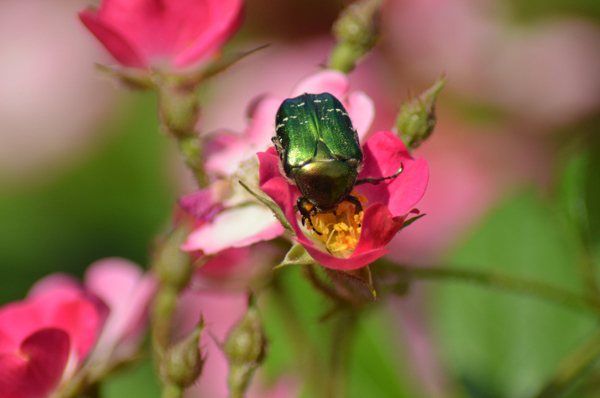

Large golden-green beetles eat petals, stamens and rose petals. Pests are removed early in the morning by hand while they are inactive.
Green rose aphid
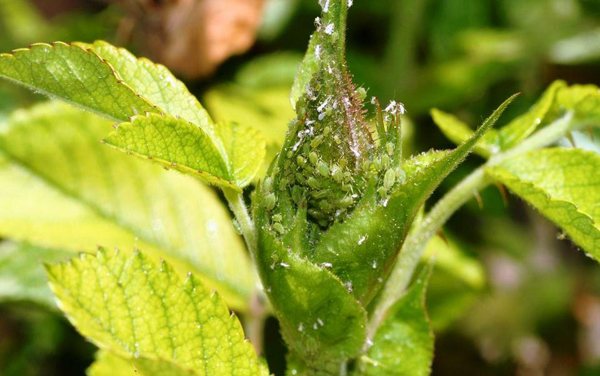

Pests settle in colonies below the leaves, on green shoots, peduncles, buds. They suck on the juice, weakening the bush. The shoots of the affected roses are bent, the leaves are curled, the buds do not bloom.
At the initial stage of the lesion, when spraying, a decoction of wormwood, an infusion of garlic, tobacco, hot pepper, yarrow, tomato tops with the addition of a soap solution is used. If there are many pests, insecticides are used: Fitover, Inta-Vir, Actellik, Fufanon.
Sawfly rosy
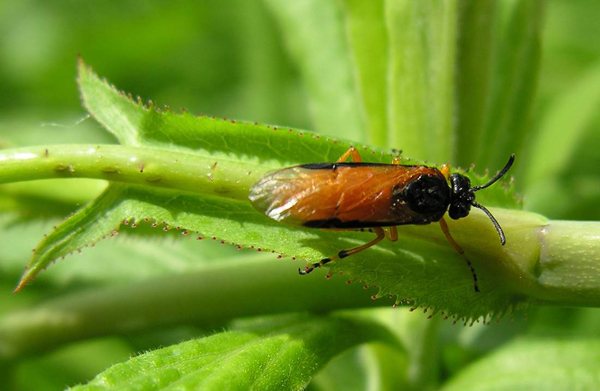

The black-brown pest resembles a bee. Its whitish larvae and light green caterpillars are considered the most dangerous for the plant. They eat up the passages in the stems, eat the buds, flowers.To combat the pest, damaged shoots are cut and burned.
Features of the content in contrast to other varieties
Unlike other varieties of roses, floribunda:
- resistant to frost;
- has immunity against diseases;
- has a wide range of shades (there are two-color and many-colored varieties);
- flowers on shoots are not located singly, but in inflorescences of different sizes, resembling brushes;
- differs in wavy flowering;
- has smooth and straight thorns;
- no plaque is observed on the sheet plate;
- flowers do not need to be cut, they fall off on their own;
- practically does not smell (some varieties have a weak aroma).
Important! The shape and size of floribunda flowers were taken from a hybrid tea rose, and flowering with multiple inflorescences, disease resistance and adaptability to the environment from polyanthus roses.
Shelter for the winter
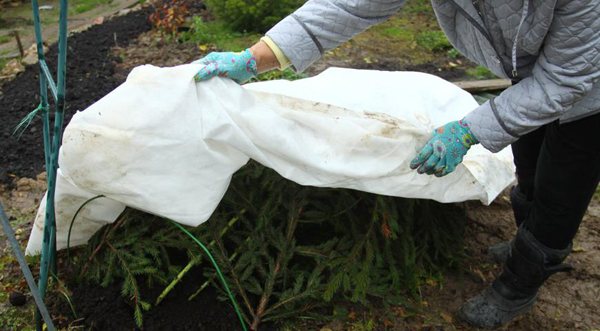

Before sheltering a bush for the winter, it needs to be prepared. Shoots are trimmed, leaving no more than 40 centimeters above the ground. All leaves are removed from the bush.
The bush is covered with earth up to 20-30 centimeters in height and covered with spruce branches, fallen oak leaves or a wooden or metal frame using a covering material. After the first snowfall, the plants are additionally covered with a snow crust to keep warm inside the shelter.
The covered rose tolerates winter well and grows overgrown with new shoots in spring immediately after removing the protective material. The shelter is removed in March or April (depending on the regional climate).
The best varieties of park roses of the English group
Roses of this variety are very beautiful, they are used in landscape design as a hedge, but they can also be used for single plantings, as bright flowering shrubs attract attention.
We also recommend reading:
16 of the most popular indoor plants Physalis: description of species and varieties, technology of growing from spruce seeds in landscape design: the best decorative varieties and features of growing Kalanchoe: description of species and features of care at home
The third advantage of the floribunda group
Long bloom - some varieties bloom without interruption, others have undulating blooms with short rest periods. It is very easy to choose varieties so that the rose garden smells fragrant and delights with flowers from spring to late autumn. It is floribunda roses that can accomplish this task gracefully and easily. Floribunda is profusely blooming, this is how the name of this group of roses is translated.
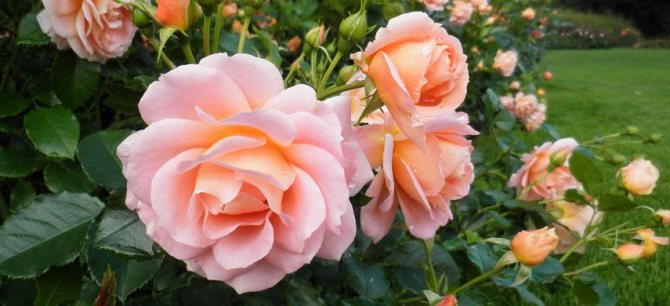

Floribunda roses can be successfully grown for cutting in a greenhouse, success is guaranteed if you select varieties with high stems and continuous flowering.
Varieties
The classification of the rose is presented according to the color and size of the buds. There are white, yellow, orange, pink, red, striped flower varieties:
- White varieties of "Floribunda". Alabaster and Cosmos became prominent representatives of such plants. The varieties are similar to each other due to the color of the petals. Delicate, beautiful petals have a creamy shade. The bushes are tall, the length reaches 1 meter or more, the inflorescences are large, the diameter can reach 9 centimeters. The bushes consist of 3-5 buds, which gives the impression of a blooming cap. There is practically no smell of flowers. Alabaster and Cosmos are not afraid of frosts, they bloom until late autumn. The varieties can be grown in the Moscow region, Siberia and the Urals.
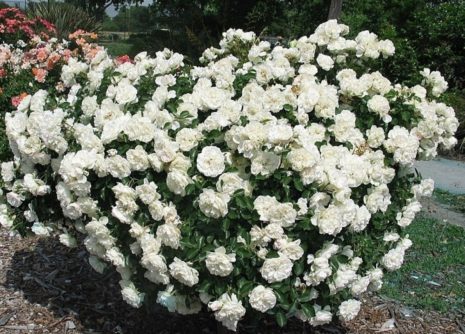

- Yellow varieties. Amber Queen is a fragrant variety that produces yellow flowers. An inflorescence with a diameter of 7-8 centimeters thinns the pleasant aroma. Amber Queen blooms from mid-summer until the first frost. The bush grows up to 1 meter. Golden Wedding is another yellow variety. It differs from the previous competitor in a brighter saturated color. Flowers grow in small groups of 3-5 pieces. Golden's bush is slightly smaller than Amber's.The variety is suitable for growing in small garden beds.
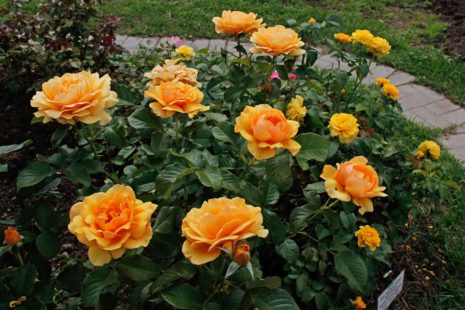

- Orange roses. Ann Harknez is a variety that begins flowering a little later than the rest of the representatives - at the end of summer. Ann is remarkable for its amazing beauty: medium-sized orange-yellow roses bloom gradually, over time, completely filling the bush. Inflorescences can contain up to 20 roses. They are not afraid of rain and cold, they tolerate winter normally. Another variety of yellow rose, Fellowship, has larger flowers with intense apricot colors. They are grouped in 5-8 pieces on each bush. Flowering begins in mid-summer and proceeds gradually until mid-October. The buds can get wet from rain and deteriorate, moisture sensitivity is worse than Ann Harkiez.
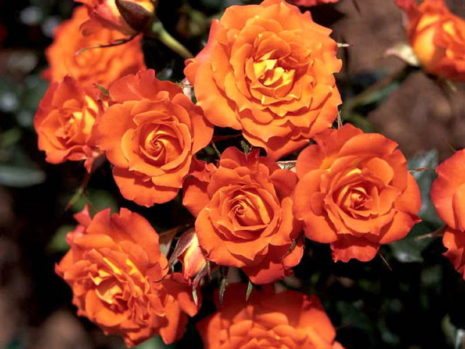

- Pink Floribunda. The standard classic color is inherent in two representatives: City of London and Sexy Rexy. The first variety has a height of up to 1.5 meters. The petals are delicate pink in color and have a velvety texture. The City of London is suitable for creating hedges, as the bushes are up to 2 meters wide. The sexy Rexie, on the other hand, is compact and suitable for breeding in small garden plots. The buds are pink in color, have wavy petals. The inflorescence contains 6-10 buds.
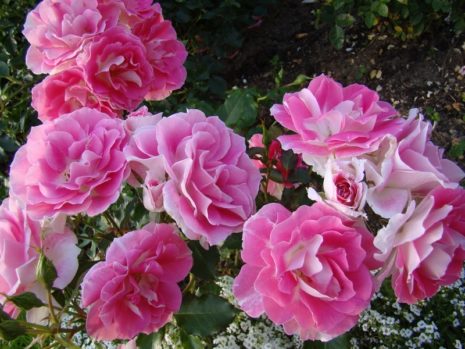

- Red representatives. The classic noble color became the main one for the Evelyn Fison variety. Evelyn is distinguished by constant flowering. The bright colors will attract the attention of everyone around them and make Floribunda the queen of any garden. The Lily Marlene variety is on par with Evelyn. Lily's red and burgundy roses will amaze any person. The shrub is not prone to overgrowth, the maximum height is 80 centimeters. Flowering takes place from the beginning of the summer period and continues until mid-autumn.
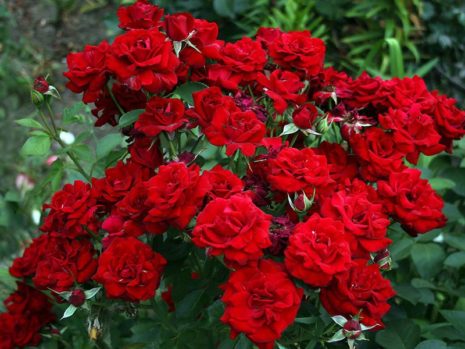

- Roses with a combined color. For connoisseurs of exotic, Orange and Lemon is suitable. The complex color combines two colors on the petals: lemon and orange. The colors intertwine with each other, forming a whimsical bright range. There is almost no smell from roses. The variety is characterized by high drought resistance and winter hardiness. The combination color is Purple Tiger. The petals are painted in a basic purple color, through which white and lilac stripes pass. Rosettes in aggregate of several pieces look harmonious and gentle.
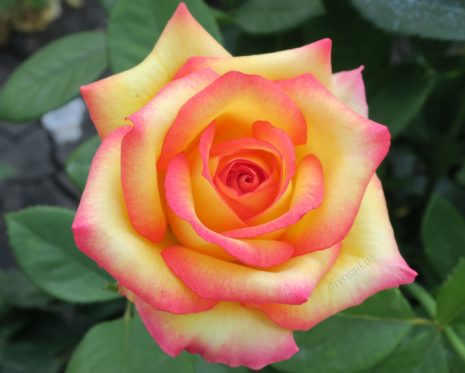

Attention! To prolong flowering, roses are fed with potassium salt or organic additives.
Description and characteristics of the rose
The floribunda group is the most extensive group of roses, whose flowers differ from other varieties in bright, juicy color. The subspecies differ externally from each other:
- flower type: simple, double or semi-double;
- bud shape: flat or goblet;
- inflorescences: multi-flowered or few-flowered;
- more than a hundred colors: monochromatic, two-tone, striped.
- bud size: 4-12 centimeters;
- flowering: intermittent or continuous;
- by the height of the bush: curb (40 centimeters), medium (60-80 centimeters), high (more than 1 meter).
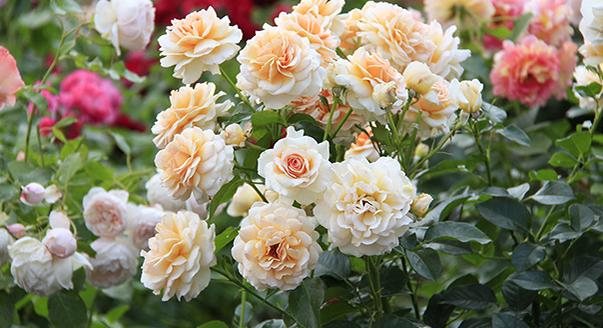

Despite the differences, floribundas have similar characteristics:
- leaves are medium, shiny, deep green;
- straight thorns;
- most of them do not smell.
Rule number 1: choose quality planting material
Low-quality hand-bought seedlings can ruin the whole business. And a bad experience will completely discourage the desire to experiment.
Therefore, do not skimp on seedlings. Buy quality planting material from proven nurseries. Give preference to plants with a closed root system: such specimens take root more easily and are less likely to get sick.
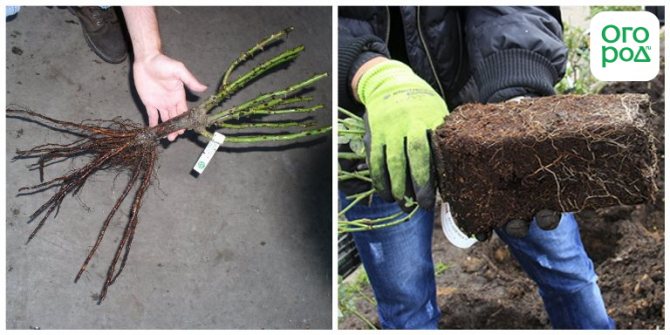

Quality seedlings can only be bought in nurseries
And, of course, choose grafted options that are resistant to cold, pests and diseases.
Rule # 6: cut on time
After planting in spring, pruning will be needed (pruning is not needed for seedlings from containers with closed roots). In floribunda roses, it is recommended to leave 3-5 buds.If the branches are weak, use a strong pruning (10-15 cm; leave 1 bud), if healthy and developed - light pruning (leave 2-3 formed buds).
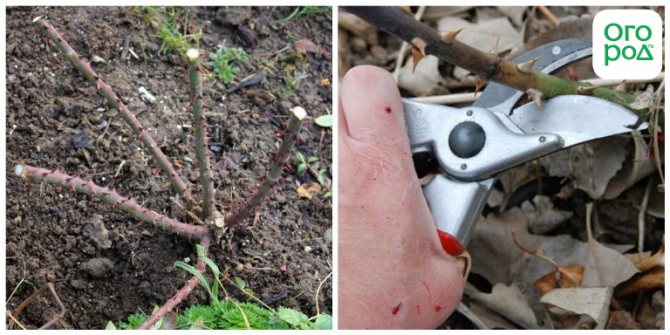

Monkeying is one of the most important stages of caring for roses.
Rose pruning is carried out 3 times a year:
- spring pruning - after planting, in the following years - before the start of sap flow (in the second half of March);
- summer pruning - a light form is carried out to stimulate flowering - shoots are cut off a few centimeters;
- autumnal pruning - removal of old, undeveloped branches, leaves for a successful wintering of the rose.
Roses - shrabs
Very beautiful park varieties of roses for the Moscow region, shrabs, are distinguished by long flowering and a particularly persistent aroma. Every gardener can choose sustainable and unpretentious plant species with abundant flowering and good health. Among the most popular varieties are the following:
- Westerland;
- Bonica 82;
- Angela.
The Westerland variety is characterized by the fact that the bush grows very quickly, has copper-orange semi-double flowers. Despite the fact that flowering lasts only 3 days, there are a lot of buds in the clusters, replacing the fallen flowers.
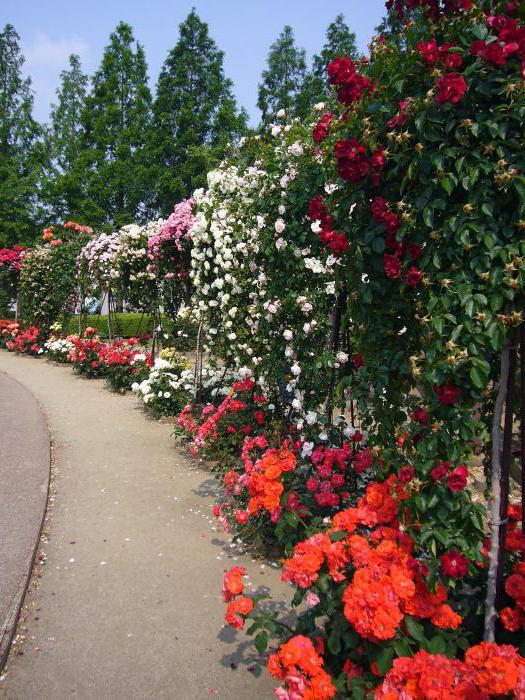

A characteristic feature of the Angela variety is a shrub with many small flowers. Among other varieties, they stand out in bright pink color, are collected in many brushes and almost completely cover the leaves.
Features of the climate of the Moscow region
The climate in the Moscow region is moderately continental. Continentality is better expressed in the eastern and southeastern regions. The seasons in the Moscow region have clear boundaries. So, winters are very cold and summers are warm.
The number of days in a year at which the average temperature does not exceed 0 ° C is from 120 to 135 days. January is especially frosty. This month, the thermometer often drops to -30 ... -25 o C. There was a case when the temperature dropped to -54 o C (date not specified). The thickness of the snow cover here rarely exceeds 30-50 cm. And the soil freezes to a depth of 0.75 m.
Summers can be cool and humid or warm and dry. It depends on the impact on the region of cyclones and anticyclones. The temperature at this time of the year varies between + 15 ... + 30 o C. Below +10 o C and above +35 o C, it is rare. Drought periods during the season can be followed by rainy periods.


